Model & Toy Cars (2018-20)
Newer toy car photos and stories are posted here.
Read more about the model car business here.
Model Car World: In a Model Auto Review posting, Maz Woolley recently wrote, "Brekina produces models in plastic, mainly 1:87 scale, which are primarily aimed at model railway fans and the continental 1:87 scale collector market."
Since 2018, Brekina has been owned by Model Car World, a large German wholesale/retail concern which owns other … (more >>>)
New Ownership: Maz Woolley of Model Auto Review wrote about some big changes in the collector scale model business.
Nicola Bulgari, famous for his car collections in the US and Italy and his multinational jewelry empire, bought Brooklin Models about five years ago. Since then significant changes have been made … (more >>>)
Big Barge: The 1958 Lincolns and Continentals were totally new in body and appearance and were assembled in a new plant. The bodies were completely restyled with an aggressive, angular look replacing the Futura dream car-inspired styling on the '56 and '57 Lincolns. The 1958 Lincolns had unit body construction; they were the largest and heaviest frameless passenger cars ever made. The '58 models weighed 5,000 pounds and, at 229 inches long, they were the longest non-limo Lincolns ever made to date.
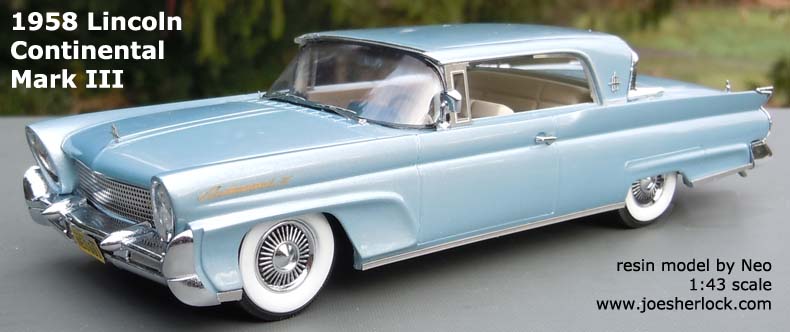
This 1:43 scale Neo model was resin-cast in China. Neo is a Dutch company that makes limited-production replicas from resin. I received this metallic light blue coupe as a Christmas gift. More about the 1958 Lincoln automobile can be found here. (posted 1/16/20, permalink)
Asymmetrical: The 1960 Plymouth XNR was a one-off concept car. Designed by Virgil Exner, the red sports roadster was based on the Plymouth Valiant chassis and was developed to show off Chrysler Corporation’s new overhead-valve Slant Six engine.
The car was built by Carrozzeria Ghia in Italy. After it completed the U.S. auto show circuit, it was shipped back to Europe where it fell into private hands. It was once owned by the Shah of Iran. Restoration of the car began in 2008 and the XNR was sold in 2012 for $935,000 at RM's Monterey auction.
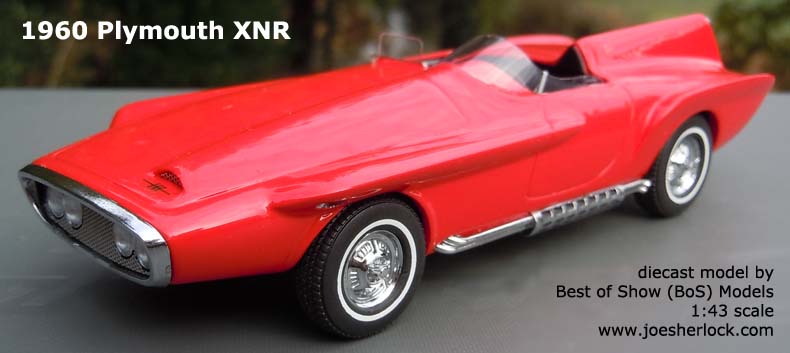
This Best of Show 1:43 scale diecast model was made in China for Model Car World of Florsheim, Germany. I received this model as a gift for Christmas. (posted 1/8/20, permalink)
Shrunken Airflow? Skoda is an automobile manufacturer located in Czechoslovakia. It was founded in 1895. In the 1930s, Skoda introduced a new line of cars featuring a redesigned chassis backbone tube and all-around independent suspension. First used on the 1933 Skoda 420 Standard, the new chassis design became the basis for Popular (845–1,089 cc engines), Rapid (1,165–1,766 cc), Favorit (1,802–2,091 cc) and Superb (2,492–3,991 cc) models. These new models were well received and, by 1938, Skoda had 38% share of the country's car market.
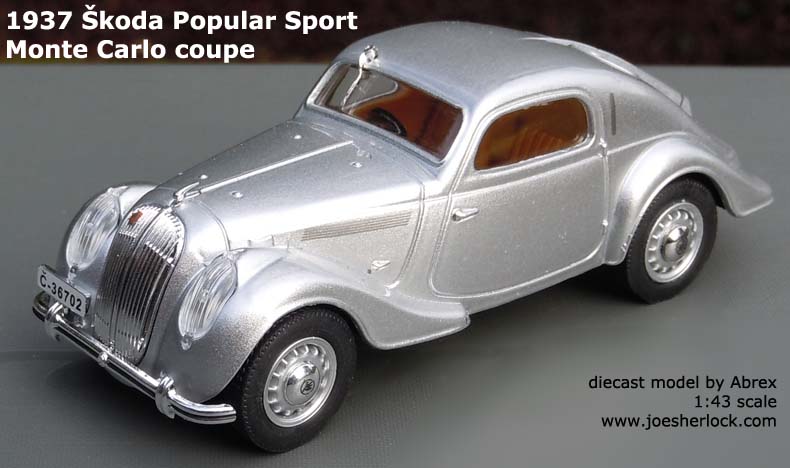
In 1934, Skoda launched the Popular Special Sport, which was an enclosed two-seater with a revised, streamlined body, a curved radiator grille and swept, fastback rear with a small center fin. It looked a bit like a miniature Chrysler Airflow. If only Chrysler had offered a three-window coupe styled like this little gem. (Interestingly, Chrysler is bringing back the Airflow name as the the 2020 Chrysler Airflow Vision Concept vehicle debuted at 2020 Consumer Electronics Show this week.)
In January 1936, Zdenek Pohl and Jaroslav Hausman drove a Popular in the Monte Carlo Rally, coming second in the 1,500 cc class. Skoda launched a Popular Monte Carlo model with a 1,386 cc, 31 horsepower 'Rapid' engine and ATE-Lockheed brakes. It was offered in enclosed or convertible Roadster, Roadster de Luxe and Coupé Sport versions. King Peter II of Yugoslavia owned a two-door Roadster de Luxe convertible.
Founded in 1998, Abrex is a maker/importer of die cast models, based in Prague. This 1:43 scale model was die cast in China by Hongwell Cararama. It was a recent Christmas gift. (posted 1/6/20, permalink)
Remembering The 1970s: Autoblog reported, "Tomica, Asia's leading die-cast toy car brand, is taking on Hot Wheels on its home turf. The 49-year-old company inked a deal with Walmart to distribute its thumb-sized cars in the United States. Already present in 130 countries, Tomica competes against Hot Wheels, Matchbox, Majorette, and other die-cast brands for the attention of collectors. Getting your hands on one previously required shopping online and paying exorbitant shipping fees, or flying to Japan. Starting in August 2019, you can conveniently put a Tomica on your shelf by driving to the nearest Walmart."
Actually, Tomica diecast cars were a staple of many chain stores in the 1970s and '80s. I used to buy them at Bi-Mart for 69¢ each in carded blister packs. They were nicely-made models - 1:60-1:75 scale depending on the model. The paint and overall quality was much better than Matchbox or Hot Wheels of the period.
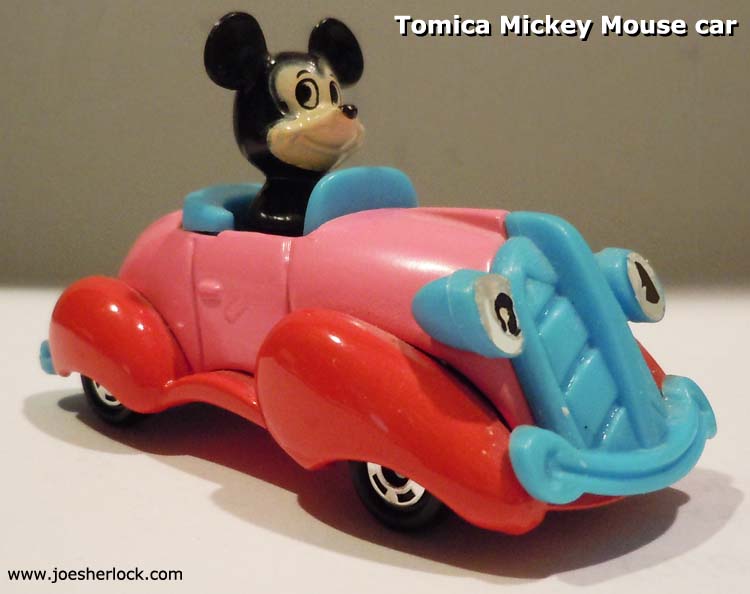
I still have a few, including a 2.5-inch long Mickey Mouse car sold at Disneyland. Tomica apparently stopped selling its little vehicles in the U.S. sometime in the 1990s. It's good that they're available again. (posted 8/14/19, permalink)
Free Shipping: I recently ordered a 1:43 scale model of a 1958 Plymouth Fury. The diecast model was offered by Greenlight Collectibles and was made in China. It is part of Greenlight's Hollywood series and depicts the red and white Plymouth used in the movie 'Christine'. It's a nice model, priced at under $20.00.
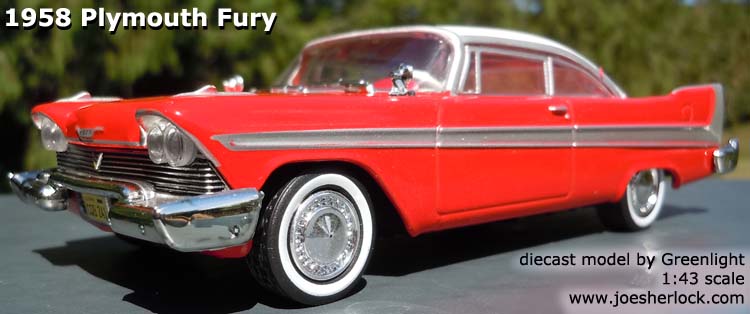
Unfortunately, I saw no other model cars which interested me. That created a problem because most online model car sites want $10 or so for shipping. (Some offer free shipping on orders of $150 or more.) Fortunately, we were putting together an Amazon order for food products which are hard to find on local store shelves anymore. I simply added the Plymouth model to the shopping cart. The order total was $40; shipping was free.
While I question Amazon's overall business model and would never buy the stock, I'm happy to purchase their stuff whenever it suits my needs. I've never had a mis-shipment, shipping mistake or damaged merchandise in 20 years.
As for the full-sized '58 Fury, factory versions were produced in a light buckskin beige (off-white) color with gold anodized aluminum side trim. 5,303 examples were produced and were equipped with V8 engines making 290-315 horsepower, depending on engine option choice. Christine, the Fury appearing in Stephen King's 1983 horror novel of the same name, was repainted in an ivory/red exterior color scheme. (posted 7/3/19, permalink)
Postwar Woody: Recently, I acquired a 1:43 scale model of a light green 1949 Dodge Coronet woody station wagon. The PremiumX diecast model was made in China.
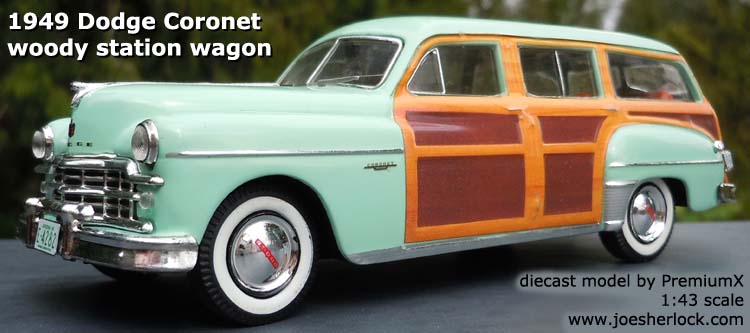
For the first part of 1949, Dodges were carryover models with the same bodies used in 1946-48. In April 1949, an new model was launched with modern postwar styling. Dodge Division proclaimed its 1949 Dodge Wayfarer model a "daring new car," explaining that it was "lower outside, higher inside, shorter outside, longer inside." The model name – Coronet – was new, and the cars were conservatively-styled in line with the demands of chief executive K.T. Keller (tall and a little stodgy-looking with enough interior headroom that a man could wear a proper hat).
The cars were offered only with Dodge's dependable 230 cubic-inch flathead six that developed 103 horsepower. Dodge used high quality components often not found standard on competitors, including aluminum pistons, automatic choke, "floating power" engine mounts, and full-pressure lubrication of the engine and oil filter. Dodge Coronet station wagons were all-steel, but had wood trim.
The new 1949 body style was introduced in April 1949. The market responded very favorably, with an incredible 260,000 1949 model year sales that made Dodge the #2 automaker in its class and sixth largest automaker as a whole, with nearly a 6% total market share. (posted 5/10/19, permalink)
Prewar Dream: I recently received a 1:43 scale, China-made, resin model of the 1941 Chrysler Thunderbolt LeBaron concept car in metallic green with copper trim. The model is a limited edition - only 240 were produced. This Matrix model is delicate, accurate and relatively expensive.
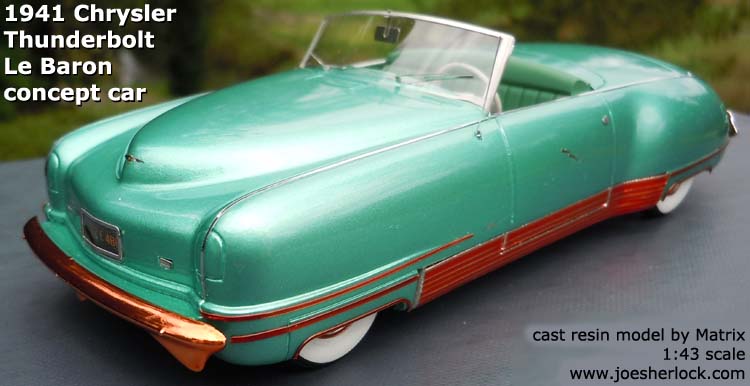
Chrysler introduced two dream cars in 1941 - the two-seat, retractable hardtop Thunderbolt and the Newport - an open parade phaeton. Both were first shown at the New York Auto Show in October 1940. The Thunderbolt - named for Captain George Eyston's streamlined 358-mph land speed record holder - was a two-door with powered retractable metal top. It was dubbed "The Car of the Future" and was an aluminum envelope-bodied, flush-fendered coupe. Pushbuttons controlled the hidden headlights, windows, rear deck and top. The Thunderbolt carried a discrete silvery bolt of lightning on each door.
Alex Tremulis - who later styled the ill-fated Tucker - designed the Chrysler Thunderbolt body while he was a young designer at Briggs Manufacturing's LeBaron studio. The car was based on a modified 1940 Chrysler Crown Imperial frame. It was powered by a 143 horsepower straight eight engine. Power was transmitted to the rear wheels by a Chrysler Fluid Drive transmission. The car rode on a 127-inch wheelbase.
Five or six examples (depending on whom you ask) were built by LeBaron. Each Thunderbolt was given its own unique color scheme.
The Thunderbolts traveled extensively to showrooms, auto shows and events across the country, drawing potential customers to Chrysler Corporation dealerships. Chrysler frequently changed colors to keep the cars fresh and exciting, but one remained immediately recognizable: The Copper Car. It was built by LeBaron with a copper hardtop, sill trim and bumpers. It survives in this unique, distinctive configuration today.
Read more about the fabulous Chrysler Thunderbolt here. (posted 5/2/19, permalink)
Easter Gifts: My daughter and I each received a blue 1938 Packard Victoria convertible model - a 1:43 scale Ixo diecast made in Bangladesh. PCT Industries owns the Ixo brand. The firm is headquarted in Hong Kong and has locations in central and western China.
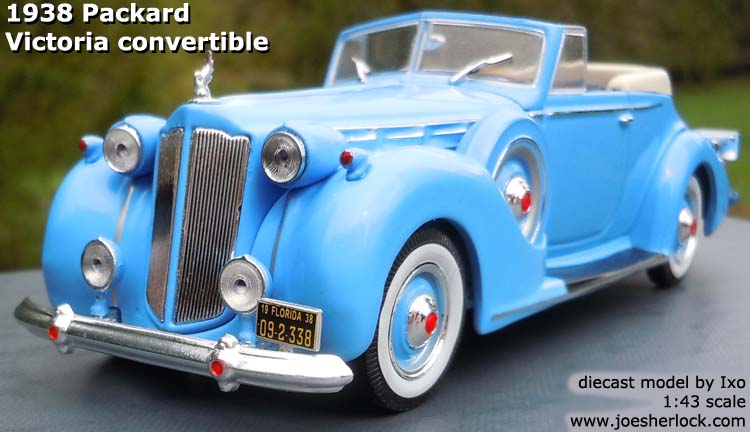
It is difficult to tell whether the Victoria is a Super Eight straight-eight, 130-horsepower model or a Packard Twelve (V12), which made 175 hp. Both Victorias shared frames and body and both rode on a 134 inch wheelbase. Whatever the case, it is a very good-looking, Packardesque rendition. (posted 4/26/19, permalink)
Big DeSoto: The 1946 DeSoto Custom 6 Suburban four-door sedan was big; it rode on a 139.5-inch wheelbase seated eight people and weighed 4,012 pounds. For Christmas, I received a 1:43 scale WhiteBox diecast model of this car finished light blue - 1 of 1,000 made in this color.
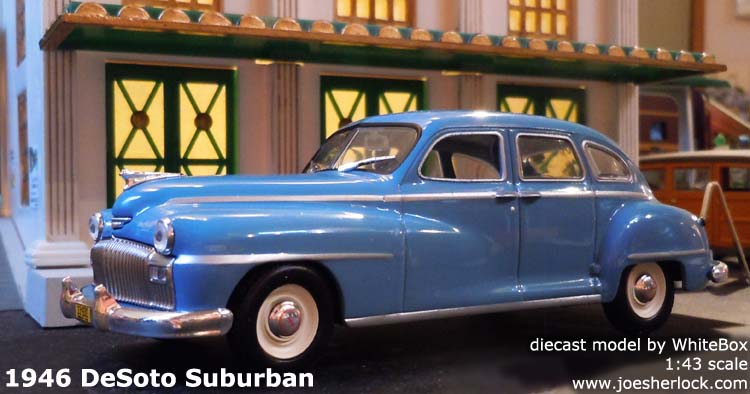
This photo was taken in front of the Union Station on my O-gauge model train layout. The cheap-and-cheerful $12 Plasticville snap-together building looks very nice when detailed with paint and glazed with translucent onion-skin paper on the windows and doors.
The DeSoto was powered by a flathead inline six-cylinder engine, which had 236 cubic-inches displacement and produced 109 horsepower. With all that weight to carry around and with the relatively low horsepower motor, it must have been sluggish. I guess that's why I've never seen a DeSoto Suburban at a drag strip.
Prices for the '46 DeSoto Suburban began at $2,093 - a 28% premium over the shorter four-door sedan. The Suburban was the most expensive model in the '46 DeSoto line. In 1946, DeSoto sales totaled 66,900. In three and one-half years of production, fewer than 7,500 Suburbans were made.
I also have a two-tone white over red one. (posted 1/24/19, permalink)
Zephyr - The Car That Saved Lincoln: The luxurious big K-Series Lincolns of the mid-1930s were fine automobiles but were priced too high for a nation in a Depression. In 1936, Lincoln introduced the mass-produced Zephyr model, which was instantly popular and saved the Lincoln marque from extinction - the fate of so many luxury auto brands of the period.
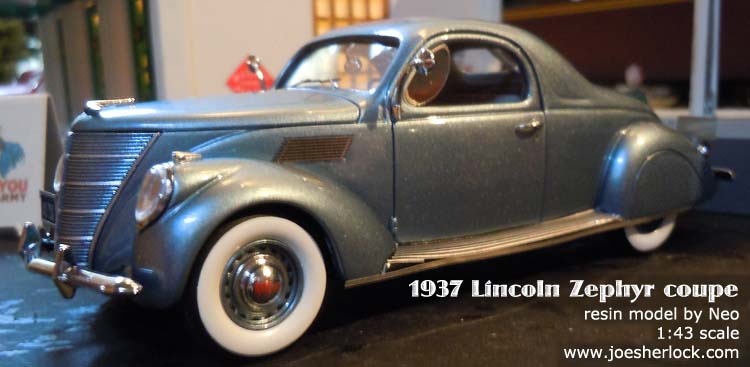
In 1937, the Lincoln Zephyr coupe was added to the Zephyr line. This 1:43 resin model was made by Neo and finished in light metallic blue.
The '37 models used the same engine as in 1936 - a 267 cubic-inch V12, producing 110 horsepower. All Zephyrs rode on a 122-inch wheelbase and were 210 inches long. The coupe cost $1,165. Lincoln sold 5,199 three-window coupes in '37.
I've written more about the Zephyr here. (posted 1/16/19, permalink)
Fifties Posh: In 1956, the Cadillac Eldorado Biarritz, convertible was Caddy's top-of-the-line offering.
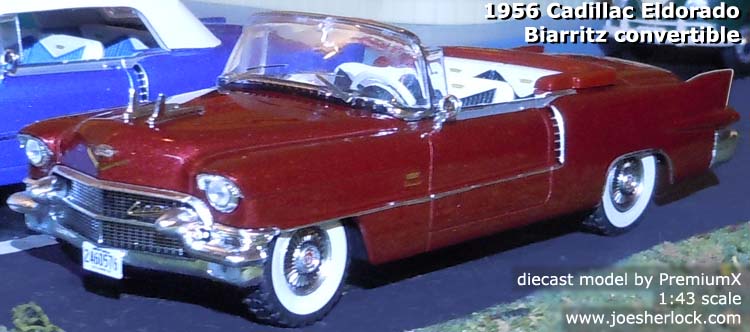
One of my Christmas gifts was a 1:43 scale top-down example of the Eldorado, finished in metallic dark red. The PremiumX diecast model was made in Shenzhen, China by Premium & Collectibles Trading Co. (PCT Co, Ltd.). This is the same firm that makes Ixo Models. I also have a blue Caddy Eldorado with top-up made by PremiumX.
2,150 examples of the pricey ($6,556) and flashy Eldorado convertible found buyers in 1956. More about the 1956 Cadillac is posted here. (posted 1/8/19, permalink)
Past Future: One of my Christmas gifts was a 1:43 resin model of the 1955 Ford Mystere concept car. Painted black over a pinkish fuchsia with a pearly white roof handle, the model was made in China by Neo.
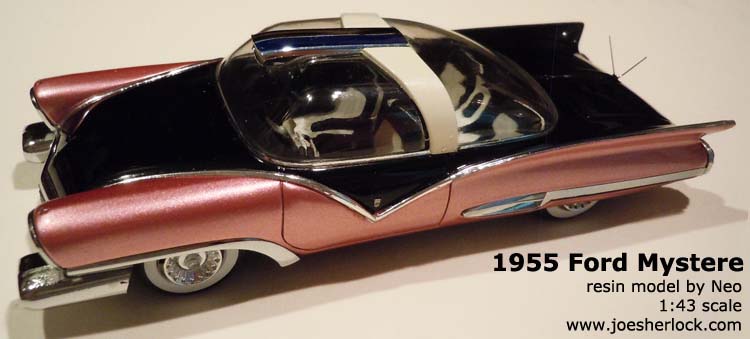
The Ford Mystere concept car - in those days, such vehicles were known as 'dream cars' - was introduced to the press in October 1955 at the Ford Rotunda. Designed by William P. Boyer, the vehicle incorporated elements of the 1955, '56 and '57 Ford models to show continuity of design between models while still having a having a very futuristic look. The name came from the French Mystere fighter jet of the period.
The Mystere rode on a 121-inch wheelbase and was 220 inches long. Height was 52 inches - the same as a 1955 Thunderbird.
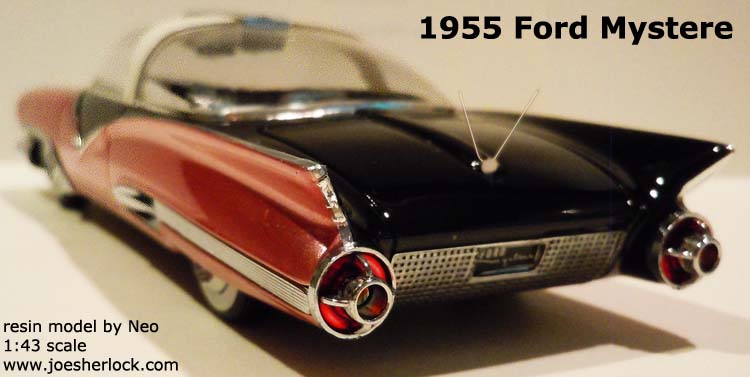
The Mystere was supposed to be powered by a rear-mounted gas turbine engine. Due to budget limitations, this concept car was only a 'pushmobile' - it had no powertrain. In fact, the doors, hood and trunk did not open; they were merely molded-in creases in the car's fiberglass body. The Plexiglas top had to be removed by hand - there were no hinged opening points. Only the lights worked. The Mystere was built by Creative Industries of Detroit, fabricator of many of the Motor City's dream cars of the '50s and '60s.
The car was displayed at the usual auto shows and then was returned to Ford where it soon went into storage. Reportedly, the Mystere was scrapped sometime in the 1970s. (posted 1/2/19, permalink)
Coolest Pedal Car Ever ...
It was exhibited by House of Kolor, a specialty paint manufacturer, at the 2018 SEMA show. (hat tip: Jesse Bowers) (posted 11/21/18, permalink)
Rare Jag: Last month, I obtained a 1:43 scale model of a 1957 Jaguar XK-SS roadster with a scale figure of Steve McQueen, dressed up in a suit as he did for his role in 'The Thomas Crown Affair', a 1968 movie starring McQueen and Faye Dunaway.
The 1957 Jaguar XK-SS Roadster was a road-going version of the famous - and far more handsome - Jaguar D-Type racer. The XK-SS was designed to dominate SCCA production-class racing. The car was priced at $7,500 and had a top speed of 160 mph. Unfortunately, a disastrous fire at the Jaguar factory limited production to only 18 examples. Steve McQueen nicknamed his The Green Rat.
The diecast car and model figure were produced by Greenlight Models in Bangladesh. (posted 9/18/18, permalink)
Two Kinds Of '40 Fords: When car guys think of a 1940 Ford, they're usually picturing a fancy, prow-nosed DeLuxe model with its distinctive front end, such as the 1:24 scale model of a red 1940 DeLuxe coupe made by Danbury Mint, pictured here.
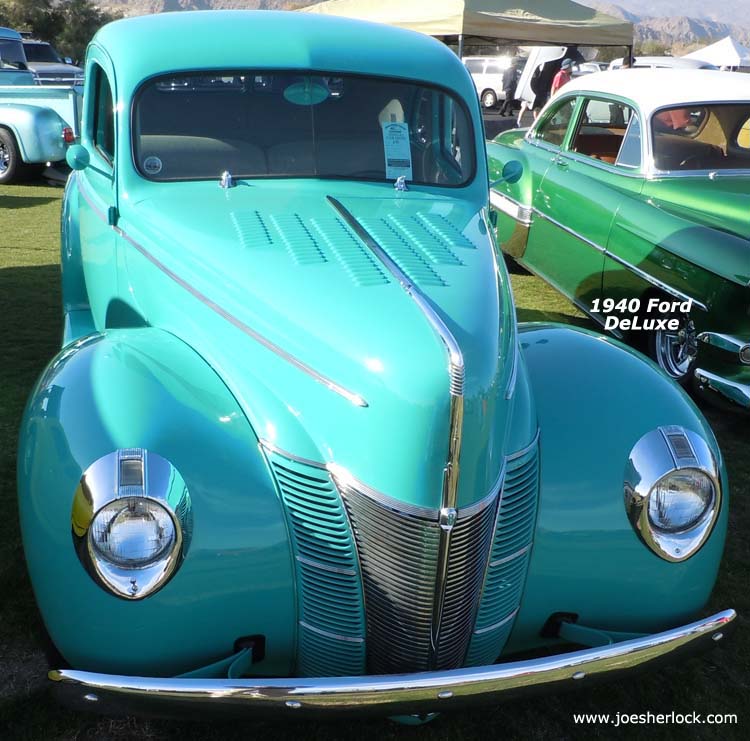
That's the one most '40 Ford street rods are based on. Ford's chief designer E.T. 'Bob' Gregorie oversaw the styling of the DeLuxe. It remains one of the handsomest of mass-produced low-priced prewar American cars. I've listed it as among the Ten Best-Looking American Production Cars.
Ford also offered an entry-level Standard model which inherited the grille of the 1939 DeLuxe model with blackout on each side of a heavy chrome center. The Standard models were reasonably popular because of their low price - $619 for a coupe with the small 60 horsepower V8 versus $875 for the DeLuxe coupe with a larger 85 horsepower V8. The Standard '40 has its fans, though - one man wrote a novel in which a 1940 Ford Standard coupe is the principal character.
Most 1940 Ford toys and models are modeled on the DeLuxe but, in 1940 or so, Tootsietoy produced a diecast 1940 Ford Standard five-window coupe. It was small - 2.625 inches long with the oversized towing attachment in the back - the car alone is 2.5 inches in length.
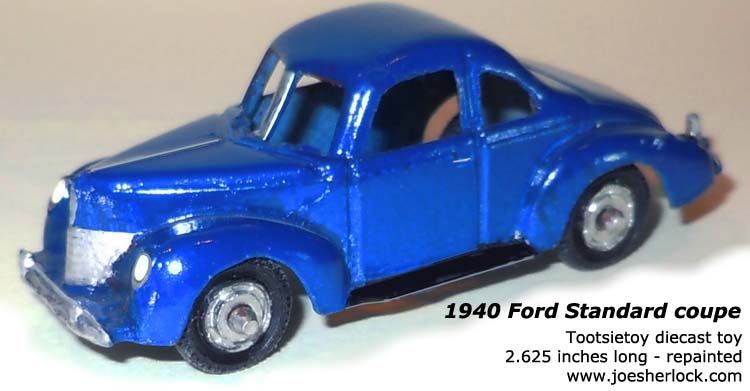
Though the Tootsietoy name has been used for toy vehicles since the 1920s, the company's origins date from about 1890.
I purchased mine in rough shape with most of the paint gone at the New Jersey Tri-State Toy Show (a glorified swap meet) in September, 1981 for a mere 25¢. I repainted the old Ford and still have it.
While at the show, I purchased a souvenir: a yellow Matchbox Models of Yesteryear yellow 1927 Talbot van - 3.625 inches long - with Tri-State Toy Show decals for $13. (posted 6/27/18, permalink)
Father's Day Gifts: I hope you had an enjoyable Father's Day 2018. My two grown children were here for the weekend and I was presented with several gifts, including seven bottles of Merlot (that should hold me for a while), as well as a book and other gifts - including three model cars:
|
|
In its 'The Godfather' series - featuring appropriate box art, Greenlight Models offers Sonny Corleone's 1941 black Lincoln Continental coupe in two 1:43 scale versions: stock, or riddled with bullet holes. I chose the stock one. Both models are made in China. I've written more about the first-generation 1940-41 Lincoln Continental here.
|
|
|
This '49 Ford woodie wagon is a bit oversize (1:40 scale) but has a pull-back action motor and opening front doors. Kintoy is a Hong Kong based die-cast toy car manufacturer established in 1992. Kinsmart models are manufactured in Shenzhen, China. According to the firm's website, "The factory is an integrated operation including prototype, tooling, engineering, production and quality control."
|
|
|
This diecast model is manufactured in China for the Editions Atlas Collection. The 1:43 scale diecast ambulance is a 1959 Cadillac bodied by Miiller-Meteor, a coachbuilder of hearses and ambulances. I've written more about the 1959 Cadillac here.
|
(posted 6/19/18, permalink)
Wagons Ho! Edsel offered three station-wagon models in 1958. All were on the Ford 116-inch wheelbase platform. (Mercury wagons had a 122-inch wheelbase.)
The upscale Bermuda wagon was based on the higher trim-level Edsel Pacer. This four-door model was offered in 6-passenger (priced at $3,190, 1,436 produced) or 9-passenger (priced at $3,247, 779 produced) versions. Minichamps offered nicely-detailed 1:43 scale diecast Edsel Bermuda station wagons in at least two different color combos.
I purchased mine in in 2004 and 2008 and use them to fill up the Edsel dealership sales lot on my O-gauge model train layout. I've written about the predestined fate of the Edsel automobile here and more about Edsel station wagons here. (posted 6/13/18, permalink)
A Ride Fit For A Pope: Pope Pius XII had several Cadillacs (prewar and postwar), including a Derham-bodied model with a throne in the back seat that could be elevated. His 1938 Cadillac V16 Fleetwood 75 Series was bodied in a town car style with an open chauffeur's compartment.
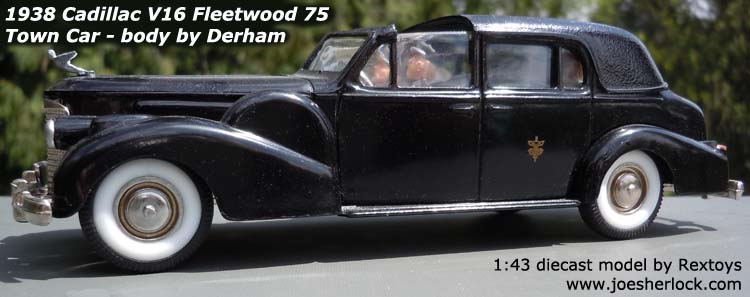
A 1:43 scale diecast model of the Pope's Cadillac town car was produced by Rextoys. Founded in 1987 by Swiss model railway manufacturer Fulgurex, Rextoys designed 1:43 scale diecast model cars, beginning with variations of 1938 Cadillacs. Production took place in Portugal, before moving its operation to France. The company released its last models in 2001. I purchased the Pius XII Cadillac model from Model Auto of Leeds, UK during a July '87 visit to the firm's retail shop.
More information about various Popemobiles is posted here. (posted 5/22/18, permalink)
How Could I Have Forgotten This? A belated Happy 50th Birthday to Mattel's Hot Wheels which made their debut on May 18, 1968. I vividly remember when they first appeared on store shelves, because they looked nothing like other little cars of the era. Sporting flashy metallic 'Spectraflame' paint jobs and modeling cool American iron, Hot Wheels instantly made all Matchbox offerings look dowdy. Matchbox saw its U.S. sales drop 75% after the introduction of Hot Wheels.
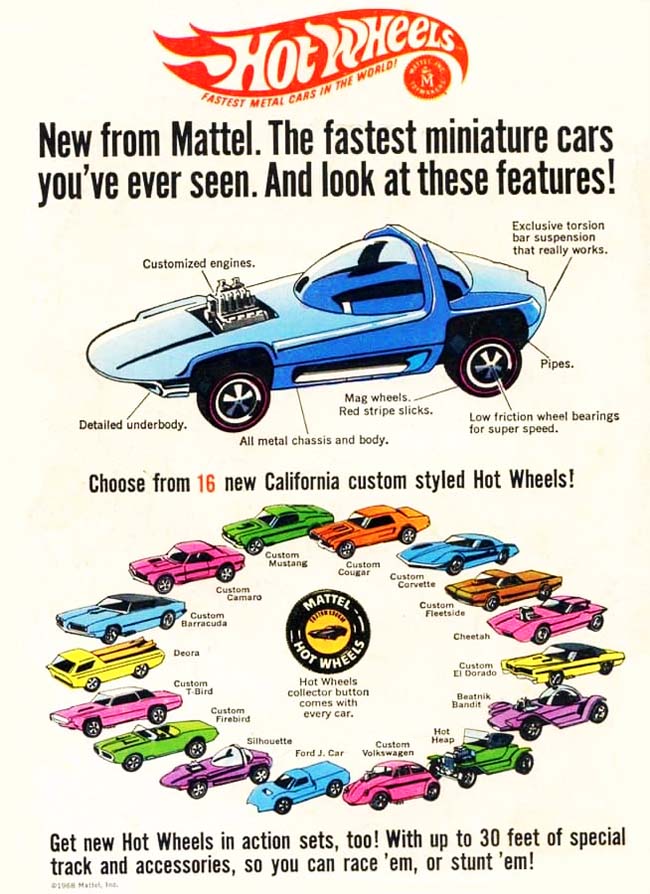
Mattel's diecast vehicles offered revolutionary features, including low-friction wheels and cool California styling. Chevy Camaros, custom VW Beetles and Ed Roth's Beatnik Bandit show rod were some of the early models produced. Some product was manufactured in America, although by 1972, all production had moved to Hong Kong.
The real brilliance of Hot Wheels was the track. For realism's sake, it should have been colored dull asphalt black but some unsung genius at Mattel suggested bright orange, making it visible down the block and creating instant envy for Hot Wheelless kids in every neighborhood. The polyethylene track also made excellent weaponry - good for sword fights, terrorizing stray animals and thrashing of younger siblings. Forget all those pop-history books which erroneously claim that the most-common 1960s phrase was, "Groovy, man" or, "Make love, not war." It was: "Mom! He's hitting me with his Hot Wheels track!"
Here's hoping that Hot Wheels are still around to mark their 100th birthday in 2068. (posted 5/22/18, permalink)
Upscaling The Downscale: In the mid-to late 1990s, Matchbox decided to go into head-to-head with Franklin Mint. The toymaker set up 'collectibles' stores, retailers who sold Department 56 buildings, Hummel figurines, and other collector items, as Authorized Matchbox Collectible dealers. Each dealer had a fancy glass display case with built-in spotlights to showcase the model vehicles. Matchbox repackaged its Yesteryear product line and increased prices by 100% or more.
Unfortunately, the strategy failed - people still thought of Matchbox as low-cost little toy cars and were unwilling to pay 'designer' prices for something with the Matchbox name on it.
Matchbox gave-up on Authorized Matchbox Collectibles and sold all of their stock to a diecast mail-order house, which offered items at fire sale prices in 2002. I purchased eight 1:43rd scale vehicles that I thought were nice, but not at the original $40 to $50 prices. I got some good Matchbox bargains at the sale, including this 1937 Dodge Airflow delivery van decorated in Budweiser Beer livery which was priced at a mere $8:
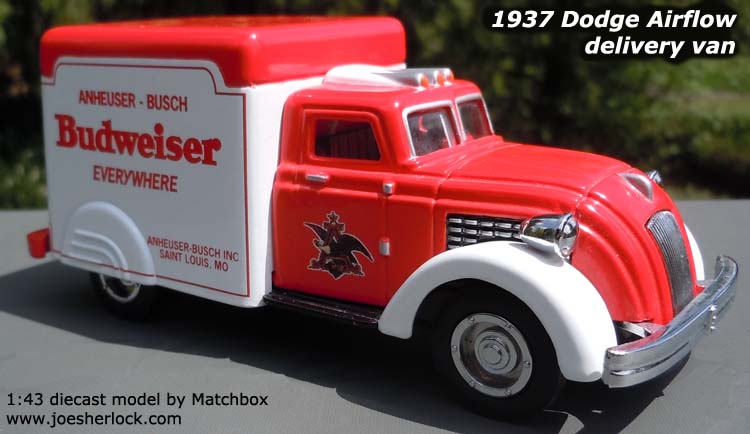
He added: "I prefer my license plates the way God intended: two-color enamel paint, embossed, and stamped by a convicted felon."
France was the first country to introduce the registration plate with the passage of the Paris Police Ordinance on August 14, 1893, followed by Germany in 1896. New York has required plates since 1903 (originally black numerals on a white background).
As to 1943 license plates, well, they'll always catch my eye because that's the year I was born.
I made my debut in Pennsylvania which did not have an actual license plate in '43, just a tab which fit awkwardly over the 1942 plate. The use of a small tab was probably due to metal shortages.
I have a few out-of-date license plates for cars I used to own. But the only plate I display (in a Plexiglas case with some of my model cars), is a small-scale plate (2.25 inches x 3.975 inches) which came out of a Wheaties box - a 1953 plate from Prince Edward Island in Canada.
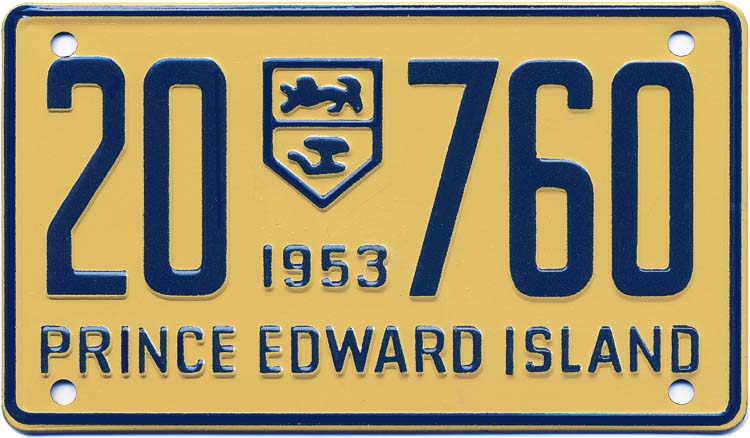
I've had it since it was poured out of the box when I was a 10 year-old.
In 1953, General Mills produced four different series of miniature license plates that came as premiums in boxes of Wheaties cereal. You could also mail in 25¢ and a box top for an envelope with 10-12 plates. This successful cereal premium program reportedly boosted Wheaties sales by 50%. Quite a few kids must have kept their little plates because each is only worth $5-7 these days on eBay.
Back to full-size license plates: Today, states produce a variety of custom license plates for almost any group. Modern printing technology allows for short-run production of multi-colored plates. A hefty premium is charged, of course, and this is a good money generator for any state licensing agency. If you're a blind cross-dresser who likes to visit the zoo, California will probably sell you and your friends a plate with a fishnet-wearing zebra with Ray Charles-style wraparound dark glasses. (posted 5/4/18, permalink)
"Well We're Living Here In Allentown ..." When I was growing up in Philadelphia, it seemed as if every truck I saw was a Mack. In those days, Mack was headquartered in Allentown, PA, about 60 miles north of Philly.
When I moved to the Pacific Northwest, Mack sightings became scarce. Most big trucks I saw were Peterbilts, Kenworths or Freightliners - all West Coast brands, with manufacturing facilities in the region.
I don't pay much attention to the truck market and was surprised to learn that Volvo now owns Mack. While Mack headquarters has moved to North Carolina, its entire line of Mack products is still assembled in Lower Macungie, a suburb of Allentown.
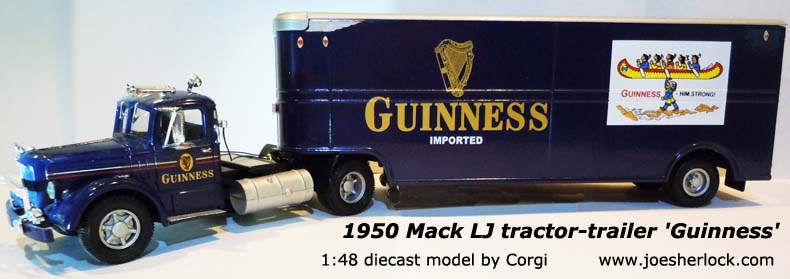
I acquired a 1950 Mack LJ tractor-trailer 'Guinness' diecast 1/48 scale model made by Corgi in 2000. It was a Christmas gift for me that year. From 1940 to 1956, 13,931 full-size LJ series Macks were made. 127,786 examples of the more popular Mack B Model were built from 1953 to '66. (posted 3/12/18, permalink)
Seasonal Scale: Every year, I put three Christmas-themed vehicles on my O-gauge model train layout:
A red 1930 Ahrens Fox fire engine has green Christmas wreath on front, Santa shares the top with a dalmatian dog, riding among cases of Coke while holding a six-ounce bottle in his hand. The Coca-Cola signboards on each side have been modified to read: 'Seasons Greetings from the Sherlocks'. I purchased this 1:43 scale Matchbox Yesteryear diecast model in November 2002.
This green 1932 Ford Model AA pickup truck model is emblazoned with 'Happy Holidays from Clayton Grain & Feed'. Made by Matchbox as part of its limited edition Models of Yesteryear collectibles, this 1:43 scale diecast was one of 9,500 produced. It features carolers and a snowman in the pickup bed with a hand-lettered Noel sign. Matchbox produced this model in 1997, I purchased it at a closeout sale in mid-2002.
A sunglasses-wearing Santa is hauling gifts in a red 1953 Lincoln Capri convertible. This heavy (13.9 ounces) 1:43 hand-cast white metal model was made in California by Precision Miniatures. Only 350 were manufactured in 1986; I purchased mine new from the late, great Autofanatics Ltd. in Sherman Oaks, CA. Decals on each door proclaim 'Santa World Tour 1986'. (posted 1/12/18, permalink)
Mmm, Mmm, Good: Campbell's is the top selling soup brand in North America. It has been so for over 70 years.
This 1:43 scale Matchbox 1932 Ford AA truck carries the Campbell's Soup livery with the slogan: 'The Most Famous Tomato Soup In The World'. And it now is, although 25 years ago, it was outsold by Heinz in Great Britain.
I purchased this model in 2001 from the late, sometimes-great KayBee Toys for only $4. (posted 1/8/18, permalink)
More toy car photos and stories are posted here.
Read more about the model car business here.
Other Pages Of Interest
copyright 2018-20 - Joseph M. Sherlock - All applicable rights reserved
Disclaimer
The facts presented on this website are based on my best guesses and my substantially faulty geezer memory. The opinions expressed herein are strictly those of the author and are protected by the U.S. Constitution. Probably.
Spelling, punctuation and syntax errors are cheerfully repaired when I find them; grudgingly fixed when you do.
If I have slandered any brands of automobiles, either expressly or inadvertently, they're most likely crap cars and deserve it. Automobile manufacturers should be aware that they always have the option of trying to change my mind by providing me with vehicles to test drive.
If I have slandered any people or corporations, either expressly or inadvertently, they should buy me strong drinks (and an expensive meal) and try to prove to me that they're not the jerks I've portrayed them to be. If you're buying, I'm willing to listen.
Don't be shy - try a bribe. It might help.
|